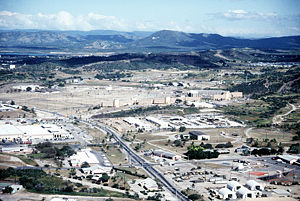Naval Station Guantanamo Bay
The U.S. is entitled, by treaty, to maintain Naval Station Guantanamo Bay on a 20 square kilometer parcel of land on the Southern coast of Cuba. The Station historically was used for coaling and other logistics, but has been used as a facility for the involuntary detention of various categories of people, from Haitian refugees to persons accused of terrorism. It has also been used as a forward base for naval patrols in the Caribbean.
The United Statest seized Cuba, Puerto Rico, Guam, and the Philippines from Spain, during the Spanish American War (1898). When the U.S. allowed Cuba to become independent, they signed a treaty with the new Cuban government giving the U.S. a lease on the site.[1][2] The treaty allows the USA to use it as a Naval Base and Coaling Station, in return for rent of $4,000 per year. After Fidel Castro took power in 1959, the Cuban Government stopped cashing the USA's rent checks to show its opposition to the treaty.
Use for detentions after 2001
During the later decades of the twentieth century, the U.S. used the Gauntanamo Bay base to detain refugees from Cuba, Haiti and the Dominican Republic. Like other off-shore military bases, the camp is under U.S. military control and is beyond the jurisdiction of the U.S. civilian justice system. The practice of detaining people at military bases is highly controversial, both publicly and legally. Like other off-shore U.S. military detention facilities, this one held persons captured in the Afghanistan War (2001-2021) and a few detainees of the Central Intelligence Agency. The George W. Bush Administration ruled that the people held there were not entitled to prisoner of war status under the Third Geneva Convention. Subsequent concerns about their treatment led to the Detainee Treatment Act (2005) and two rulings by the U.S. Supreme Court, Rasul v. Bush (2004) and Boumediene v. Bush (2008)[3]. In 2009, the Obama Administration announced its intention to close the facility, and a majority of the prisoners were released to other countries (often after years in captivity)[4]. As of April 2023, 30 remained in Guantanamo Bay detention, and 9 had died there. The vast majority were never charged with, much less convicted of, a crime.[5] |}
References
- ↑ Agreement Between the United States and Cuba for the Lease of Lands for Coaling and Naval stations. The Avalon project, Yale Law School (February 23, 1903). Retrieved on 2007-0.
- ↑ . The treaty was updated in 1934. Treaty Between the United States of America and Cuba. The Avalon project, Yale Law School (May 29, 1934). Retrieved on 2007-06-20.
- ↑ Wikipedia has a description of Boumediene v. Bush
- ↑ See Combatant Status Review Tribunal for some of the reasons slowing down the release of detainees from this facility.
- ↑ In a rare move, U.S. release 'high-value' Guantanmo prisoner by Missy Ryan, Washington Post, Feb. 2, 2023.

